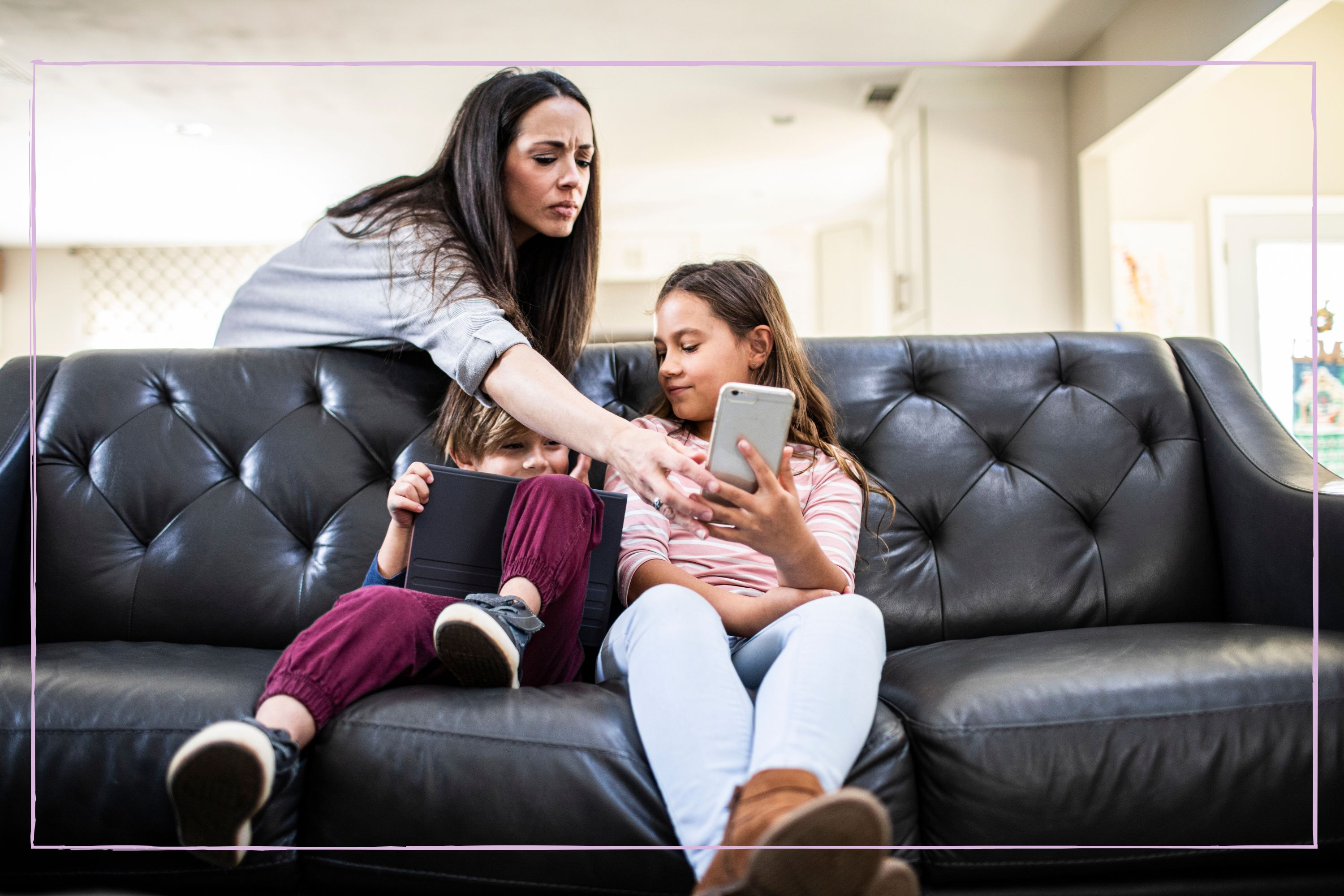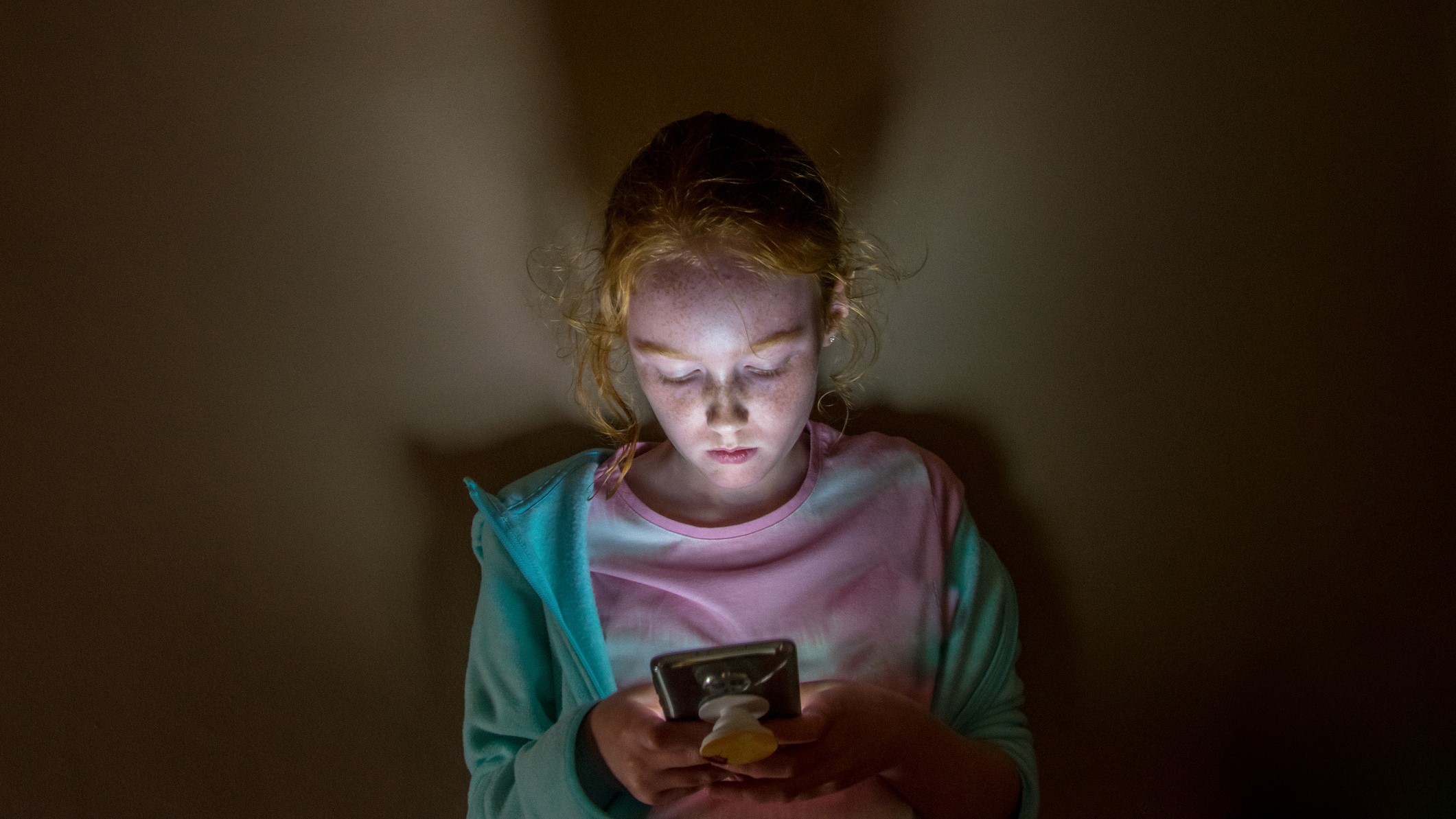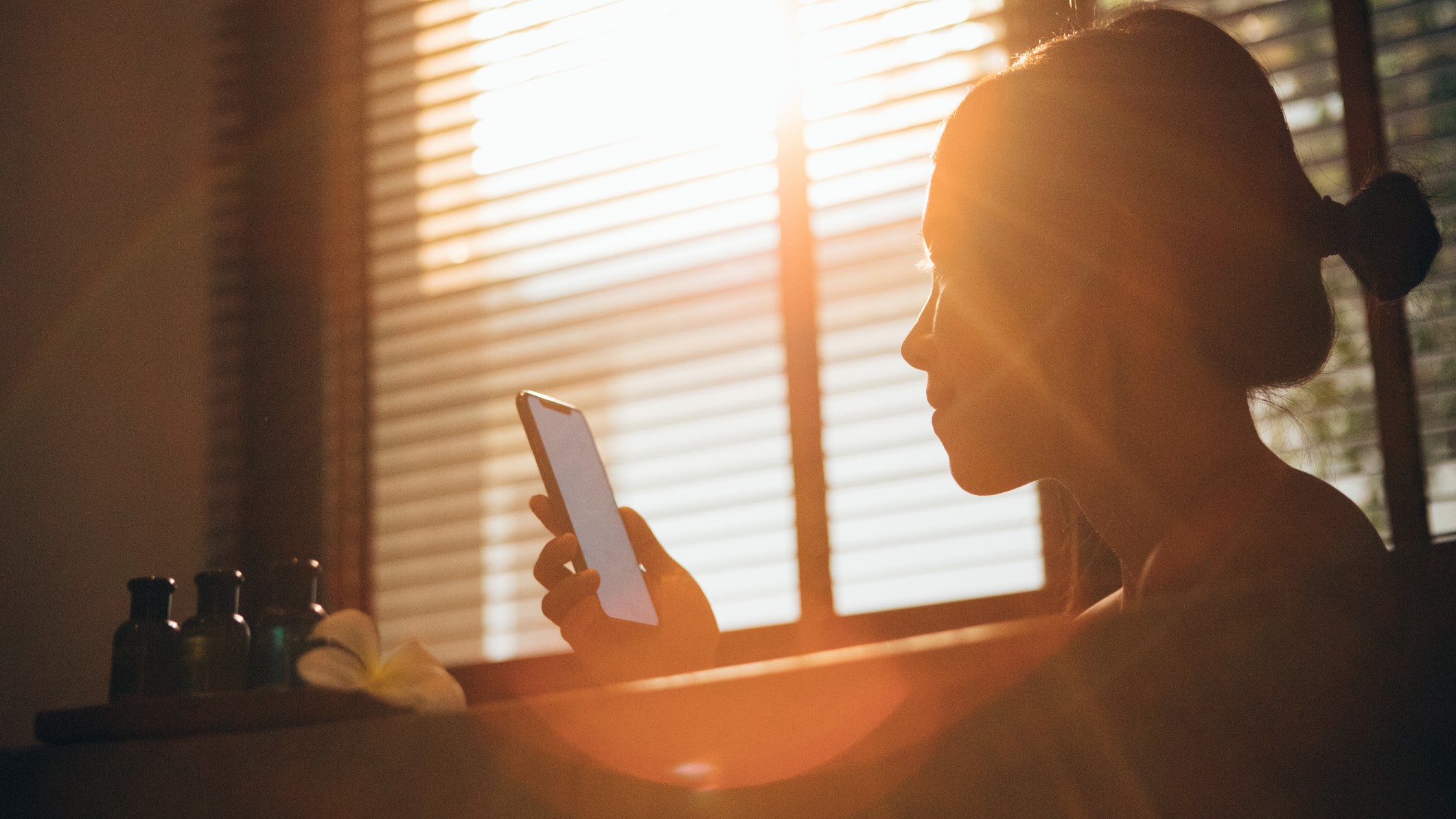
Social media can be an important way for your child to interact with friends and peers. But as more younger teens and even children create their own profiles on Insta, TikTok, Snapchat and Discord, it's time to ask: Is social media bad for our kids?
Parents used to be worried about too much screen time affecting cognitive development, but now we're asking just how bad social media is for our children's mental health. Alarming figures from Ofcom reveal that children as young as five are accessing content on social media now and as many as 80% of 8-17-year-olds use social media apps.
Mental health expert Jennifer Kelman is concerned about how easily kids get access to social media platforms these days. "I believe parents are too quick to hand their child the latest iPhone with Instagram and other social media sites," she says. While she acknowledges that screen time can have benefits for kids who use social media to connect with friends, "It's when the mindless and endless scrolling takes over that all potential benefits of connection are lost." And while there's never any judgement here - we get it, sometimes after a long day the tablet and twenty minutes of silence is a mental health option - here are some of the reasons parents need to take an active interest in and make conscious decisions to secure safety across social media is a need to know.
From TikTok to Snapchat, Instagram to Facebook, we've got information and advice about the risks and dangers of social media for your child. Plus, we've spoken to child mental health experts and social media experts to discover more about the risks and what you can do to protect your child.
Just how bad is social media for kids?
- Sharing inappropriate images
- Receiving unsolicited images and videos
- Cyberbullying
- Predators and being groomed
- Dangerous online challenges
- Identity theft and fraud
- Perpetuates poor body image
- Self-harm
- Fake news and misinformation
- Invasion of privacy
- Addiction to social media
- Accessing pornography
Dr Lisa Strohman, clinical psychologist and founder of Digital Citizen Academy, emphasises the risks associated with social media, particularly Instagram, which promotes photo sharing, leading to social comparison, body image concerns, cyberbullying, and FOMO-induced risky behaviours among young users.
"The inherent risks of using social media platforms, especially those such as Instagram that promote highly edited photo sharing, are nothing but abundant," says Dr Strohman.
Despite Meta's announcement of plans to shield teenagers on Instagram and Facebook from harmful content, making it harder for them to access material related to sensitive topics like suicide, self-harm, and eating disorders, experts and research worldwide say it's not working.
Studies across the globe continue to uncover risks such as poor mental health, low self-esteem and addiction among children and teens who use social media platforms. We also know that social media can increase the risk of children being cyberbullied and groomed and having their privacy invaded. Let's dig into the research a little more to understand the risks and see what the experts have to say.
Sharing inappropriate images
It's concerning how many kids these days are sending nude, partially nude, or sexual pictures and messages to each other. This can have terrible consequences, especially if those pictures or messages get into the wrong hands or spread all over the internet for everyone to see and share.
"It's also important to communicate to your child that anything that exists online has a risk of being made public, even if sent in a private messaging app or forum," says Tom Gaffney, online security expert at F-Secure. "Ideally, children should not post any pictures online at all, especially on a publicly accessible platform. Ask your child to disable any geotags on their phone to avoid oversharing personal data. Bear in mind the availability of deepfake technology has unfortunately made it very easy for criminals to create illicit versions of a completely innocent photograph and even distribute it on the dark web."
The website Teenage Helpline has advice on what to do if you've sent a nude picture and regret it now. If you're under 18, you can report it to the law enforcement agency called Child Exploitation and Online Protection. Asking for or threatening someone under 18 for nude pics is illegal. And if you're over 18, posting someone's private nude images online without their consent is also against the law.
Receiving unsolicited images and videos
According to Forbes magazine, over half of children aged 10 to 12 have been exposed to inappropriate online content, including hate speech, sexually explicit images and videos.
Internet Matters says the risk of your child receiving these inappropriate images and videos increases if they:

- join a social network before reaching the minimum age
- have unsupervised access to the internet at home
- play games and use apps that are not in the appropriate age range for them
- take part in live streams
- use devices with no parental controls in place
If your child tells you that they've received inappropriate content, the first step is to remain calm and avoid overreacting. Let them know that they are not in trouble and that you appreciate their honesty in coming to you.
On social media or messaging platforms, guide your child on how to block the user who sent the content and report them to the platform for violating terms of service related to non-consensual explicit material. The NSPCC has more advice and information for parents of children who have been exposed to inappropriate content.
Cyberbullying
An ONS report reveals that 1 in 5 children aged 10 to 15 experienced cyberbullying in the past year. Among these schoolchildren, only 70% reported that the bullying was from someone at their school. Meanwhile, 5% of students said they received abusive messages or offensive posts from strangers online, highlighting how bullying has evolved in the digital age.

Teach your children how to block users and report content that upsets them. Let them know they can talk to you about cyberbullying, just like any other form of bullying. If they're hesitant to open up, encourage them to reach out to a bullying charity like BullyingUK. Avoid banning them from using their phone or computer, as this might make them feel more isolated. The internet can be a valuable resource for finding support.
Advise your child not to respond to nasty messages, no matter how tempting it might be. Bullies often seek a reaction, so it's important they don't get the satisfaction.
Ask.fm has made headlines many times due to cyberbullying issues, and its poor regulation has sparked a lot of controversies. On Ask.fm, anyone can see another user's profile and posts, and people can ask questions anonymously. This means your kids might accidentally share personal information or become targets of unwanted anonymous comments and cyberbullying.
Predators and being groomed
On social media, it's very easy for people to pretend to be someone they're not. Children often end up chatting with people whose real identities they don't actually know. Predators may go on social media sites popular with kids and act just like kids, using fake profile pictures, pretending to have the same interests, offering gifts, and saying lots of nice things. The goal is to get the child's trust. Kids may not be able to tell if someone is genuine or faking it.
An Ofcom report found that 30% of kids aged 12-15 said a stranger online had tried to become their friend. So there's a real chance your child could meet people online who aren't who they claim to be.

Every parent worries about online grooming, which is why it's so important to talk to your kids about staying safe. Make sure they know not to trust someone right away, even if they seem nice and have common interests. Remind them to never share personal information or arrange to meet up.
"Social media is where predators go to find and target teens," says Jennifer Kelman, a mental health expert. "If a teen is pressured into sending a nude pic of themselves, they may become a victim of sextortion. This is where the person threatens to share the photo publicly unless the teen pays them money or tells their school or parents. These kids feel completely desperate and helpless, and tragically, we're seeing more and more cases of teen suicide because they don't know where to turn."
Dangerous online challenges
In recent years a number of dangerous online challenges have swept social media, encouraging children to try outrageous and potentially fatal activities in the hope of getting hundreds of likes and comments. They include the blackout challenge, where children are encouraged to hold their breath until they lose consciousness. Another example is the choking game, where teens choke themselves to induce a high. These viral challenges have resulted in multiple injuries and even deaths - by November 2022, 12 children had died as a direct result of the blackout challenge. Another challenge called 'chroming' involves sniffing toxic fumes from household chemicals such as nail varnish remover or permanent markers. Sadly, this challenge recently claimed the life of an 11-year-old boy in the UK.
It's vital to talk to your child or teen about the viral challenges they may see online. Encourage them to think critically about the challenge, and how it might affect them or their friends. Even if they haven't seen these challenges yet, talking to them early about the dangers they pose can help.
Identity theft and online scams
You may think identity theft and scams only affect older people on the internet, but children are just as much at risk. In fact, Ofcom found that a quarter of 13-17-year olds have experienced scams, fraud or phishing online.
Internet Matters shares a number of signs that your child may have experienced identity theft:
- Unexpected bills, subscriptions or services in your child's name.
- Unfamiliar emails filling your child's inbox.
- Letters to your child from official organisations such as the government, banks or financial organisations.
If you have any concerns about your child experiencing identity fraud or other online scams, contact ActionFraud.
Tom Gaffney, online security expert, has more: "Unfortunately, hacks and breaches happen, and they're often out of your control. But once details of an account are compromised, it's important to change the password and any other associated accounts. You should routinely check your and your child's email address using a free ID theft checker, which will inform you of any web services that have been hacked, if data has been exposed and what information has been compromised (name, email, password, etc.)."
Poor body image
Kids are now inundated with filtered perfection on social media, distorting their ability to see beauty in themselves. A 2021 survey found that young people aged 13-21 who used beauty filters on social media were much more likely to want cosmetic surgery and even change their skin colour.
While studies don't always differentiate between genders, many agree that girls tend to be affected more - with higher risks of anxiety and depression. Teenagers obsess over presenting a certain image on social media and constantly compare themselves to others, making them feel worse about themselves.
Dr Strohman explains, "Filtering and editing photos creates a false reality and sets unrealistic beauty expectations for young women and men alike. Girls may edit their noses to look slimmer, while guys may add more muscle tone than they actually have. This undoubtedly causes millions of teens to become anxious and insecure about their appearance compared to the unrealistic standards set not just by celebrities, but their peers too."
Have open conversations about the edited fantasy world of social media versus realistic self-image and self-worth. The Child Mind Institute has tips on how to encourage your child to help them build a safer relationship with their social feeds:
- Take social media seriously: Acknowledge the impact of social media on your child's life. Listen to their experiences and avoid minimising their feelings.
- Encourage critical thinking: Ask your kid to show you some social media images from their favourite influencers or friends and discuss the reality behind these images. Ask questions about what might be cropped or edited and encourage your kid to explore how 'real' these pictures are.
- Model healthy responses to failure: Be open about your own failures and show acceptance. Teach your kid that failure is a learning opportunity, not a source of shame.
- Praise effort, not just outcomes: Recognise your child's hard work regardless of the result. Share your own efforts, especially those that don't end in success, to set a positive example.
- Take a “social holiday”: Encourage breaks from social media and participate in these breaks yourself.
- Unconditional love and pride: Let your child know that you love them and are proud of them as they are, helping them build confidence and resilience.
- Avoid filtering your own pictures: Actively model realistic social media updates and images, and avoid using filters and criticising how other people look online in front of your child.
Self harm
In January 2024, Meta announced new measures to hide harmful content from teenagers on Instagram and Facebook, responding to increasing pressure from regulators. These steps aim to make it harder for kids and teens to access content related to sensitive subjects like suicide, self-harm, and eating disorders.
Despite these assurances, global studies continue to show that children and teenagers remain at risk of poor mental health and negative self-esteem due to using social media platforms. Girls are more than twice as likely to self-harm than boys, according to The Good Childhood Report.
Worryingly, 'digital self-harm' has increased in recent years. This describes a practice where children or teens encourage others to abuse them on social media. Sometimes called 'roasting', young people invite others to criticise them, reinforcing their own negative beliefs that they are stupid, fat, ugly or worthless.
If you suspect your child is physically self-harming or digitally self-harming, the first step is to encourage them to talk to you about it. Find out why they're trying to harm themselves and offer them plenty of emotional support. Listen to them without asking too many questions or judging them, and encourage them to find healthy ways to cope with difficult feelings. You can find more advice and information about self-harming on the NSPCC site.
Fake news and misinformation
Ofcom's recent report highlighted the growing issue of children and young people accessing fake news and misinformation online. Around a third of 8-17-year-olds believe that almost everything they see on social media is true, while 7 in 10 12-17-year-olds said that they were confident they could identify fake or misleading information online. In reality, only a quarter of them can. This can leave children exposed to harm from social media hoaxes, phishing emails, sponsored posts, deepfakes and parody videos.
Helping your kids become critical thinkers is key to avoiding harm from misinformation. Talk about fake news in the home, and show them examples of fake stories and AI-generated videos (you can find plenty of useful examples and tips on BBC Bitesize). Encourage them to ask you if they're not sure about an online claim or story and use fact-checking tools, such as Full Fact or BBC Verify, to check pictures, sources and more.
Invasion of privacy
It's important to be aware of the risks that being online can bring, especially when it comes to protecting your child's privacy on social media. Kids can inadvertently reveal much more about themselves to strangers online than they would in real life, such as their age and location.
"Social media platforms give you the option to go private, and children most certainly should," says social media expert Eve Lowdon. "This keeps strangers from seeing what they’re doing, saying, and posting, which protects their privacy. It’s as simple as a flick of a switch and should be set at the point of account creation."
It's also critical to keep on top of privacy settings, according to social media manager Chelsea Hopkins. "Regularly review your child’s privacy settings to make sure nothing has been changed, either on purpose or through an update that may inadvertently reset some options, to keep your child as safe as possible," says Chelsea. "New updates also occasionally bring new privacy and security settings, so it can be worth going through to see if there’s anything that could add an extra layer of protection."
Don't forget to monitor what you post online about your child, either. Many parents inadvertently 'sharent' (share info online about their kids), such as where they go to school or places they visit. Sharing images of your children can be a lovely way to connect with others on social media, but be mindful of who has access to them.
Addiction to social media
Social media addiction is becoming a bigger problem for children and teenagers. Nearly half of British teens admit they feel addicted to their apps and feeds.
If you're concerned about how much time your child spends on social media, there are easy and practical ways to talk to them about it and help them find other ways to connect and share.
- Communicate: Discuss social media with your child positively, focusing on its benefits like helping with homework and staying connected with friends. Encourage them to talk about what they see online, reassuring them you won't overreact.
- Have digital detoxes: Establish times when social media use is off-limits, like during dinner, after 9pm, or before breakfast. Consider unplugged weekends and plan alternative activities like family outings.
- Lead by example: Model responsible social media habits by monitoring your own usage, especially around your family. Be mindful of screen time during family moments.
- Suggest alternatives: Encourage physical activities and spending time with friends away from screens. Balance between online and real-life experiences is key.
- Set limits: Instagram's 'Your Activity' feature can help your child set reasonable limits and know when to log off.
- Get parental controls: Utilise tools like Screen Time on iOS or Family Link on Android to enforce app limits and block access when necessary.
If you're still concerned about your child or teen's social media addiction, ask your GP for help or look for a private therapist who specialises in online addiction. Websites such as UK Addiction Treatment Centres and UK-Rehab have advice and information on internet addiction.
Accessing pornography
There's no doubt that the statistics around children accessing online pornography are frightening for parents. A report by The Children's Commissioner in 2023 found that one in 10 children have seen pornography by the age of 9, and more than a quarter have seen it by the age of 11. It also found that girls and boys are just as likely as one another to see pornography at this age. You may think that sites such as Pornhub are to blame, but X (Twitter) is the site where most young people see pornography, closely followed by Instagram (33%) and Snapchat (30%).
As children get older, they are more likely to actively seek out porn. According to the same report, 58% of boys and 42% of girls aged 16-21 say they had intentionally looked for pornography online.
Early access to pornography has been found to increase consumption of it, and it is also linked to harmful attitudes and behaviours later on. Online pornography frequently involves sexual violence and abuse, such as choking or slapping. This, in turn, has led to a rise in young people (41%) experiencing violent sex acts, with girls significantly more likely than boys to be at risk.
Alongside setting parental controls and safety settings and reporting pornographic content on social media sites, it's crucial for parents to talk openly about pornography with their children. Help them understand that it's an unrealistic view of sexual encounters and emphasise the importance of mutual respect and consent when it comes to sex. You can find more helpful advice and information on how to speak to your child about pornography from the age of 5 right through to teenagers on Internet Matters.
In other family news, here are 15 'life-saving' questions to ask your child if they’re online gaming - plus 5 expert tips for keeping your kids safe and did you know that screens aren't the only reason kids aren't playing outdoors?.







